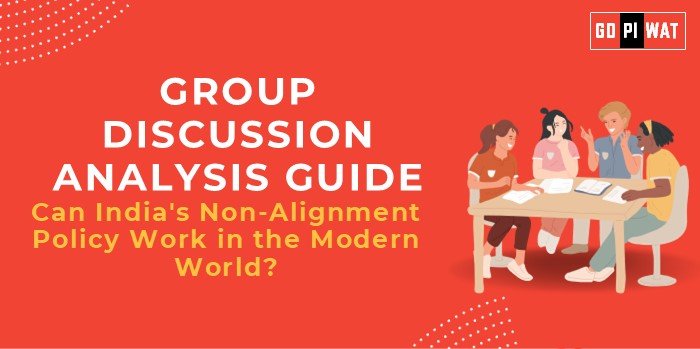📋 Group Discussion (GD) Analysis Guide
🌐 Can India’s Non-Alignment Policy Work in the Modern World?
🌍 Introduction
India’s non-alignment policy, a cornerstone of its diplomatic strategy, was established during the Cold War to maintain neutrality amidst competing global blocs. In today’s multipolar world, the relevance and adaptability of this approach are under scrutiny as India balances its historic stance with emerging strategic imperatives.
📊 Quick Facts & Key Statistics
- 📜 Origin: The Non-Aligned Movement (NAM) was founded in 1961 in Belgrade, Yugoslavia, by leaders from India, Egypt, Yugoslavia, Ghana, and Indonesia.
- 🌍 Membership: As of December 2024, NAM includes 120 member states, representing 55% of the global population.
- 📈 Global Trade: In FY 2022-2023, India’s trade with the U.S. accounted for 24.44% of its total trade, and with China, 17.18%.
- 🔄 Geopolitical Shifts: India’s diplomatic approach is transitioning from non-alignment to multi-alignment, reflecting the demands of an evolving global order.
🤝 Stakeholders and Their Roles
- 🏛️ Indian Government: Implements policies balancing traditional neutrality with emerging partnerships.
- 🌐 Global Powers: The U.S. and China influence India’s strategic calculus through economic and defense ties.
- 🤝 NAM Member States: Advocate for equitable global governance and sustainable development.
- 🏢 International Organizations: Offer platforms for India to mediate global challenges, leveraging its neutral stance.
📈 Achievements and Challenges
🏆 Achievements:
- 🤝 Global Mediation: India’s neutral stance has facilitated dialogue in global conflicts, enhancing its reputation as a mediator.
- 💼 Economic Partnerships: Multi-alignment enables robust trade relations with major economies like the U.S. and China.
- 🛡️ Strategic Autonomy: Maintains sovereignty in foreign policy decisions without over-reliance on any bloc.
⚠️ Challenges:
- 🤔 Strategic Dilemmas: Balancing U.S. and Chinese interests while retaining neutrality is increasingly complex.
- 📉 Evolving Relevance: The rise of strategic blocs raises questions about non-alignment’s efficacy.
- 🌏 Global Comparisons: Countries like Germany have successfully adopted hybrid approaches to strategic alliances.
🗣️ Effective Discussion Approaches
💬 Opening Approaches:
- 📊 “India’s trade ties with global powers like the U.S. and China reflect a nuanced shift from non-alignment to multi-alignment.”
- 🕊️ “As NAM marks over six decades, its relevance in a multipolar world demands reassessment.”
🤔 Counter-Argument Handling:
- 💡 Highlight how multi-alignment complements rather than replaces non-alignment.
- 📘 Use trade and strategic partnerships as examples of pragmatic neutrality.
📌 Strategic Analysis of Strengths & Weaknesses
✅ Strengths:
- ✔️ Autonomy in foreign policy.
- 🌐 Leadership potential in NAM.
- 📈 Diversified trade relations.
❌ Weaknesses:
- 📉 Challenges in influencing major global blocs.
- ⚠️ Reduced leverage in strategic alliances.
🌟 Opportunities:
- 🌏 Leading climate change diplomacy.
- 🤝 Expanding partnerships in the Global South.
⚠️ Threats:
- ⚔️ Risk of alienating key allies.
- 💼 Geopolitical tensions with rising blocs.
📚 Structured Arguments for Discussion
- 🟢 Supporting Stance: “Non-alignment ensures India’s independence in policymaking and conflict mediation.”
- 🔴 Opposing Stance: “In today’s interconnected world, non-alignment limits India’s strategic influence.”
- ⚖️ Balanced Perspective: “While non-alignment preserves sovereignty, selective alignments could enhance India’s global role.”
🎓 Connecting with B-School Applications
📖 Real-World Applications:
- 🌍 Analyze non-alignment as a model for maintaining autonomy in business strategies.
- 💼 Explore parallels between India’s foreign policy and risk diversification in corporate portfolios.
❓ Sample Interview Questions:
- 💬 “How does India balance its historic non-alignment with modern multi-alignment?”
- 🧐 “What lessons can global corporations learn from India’s diplomatic strategies?”
💡 Insights for Students:
- 📘 Evaluate the role of strategic flexibility in global leadership.
- 🔍 Study the balance of traditional values and modern demands in policy formulation.


